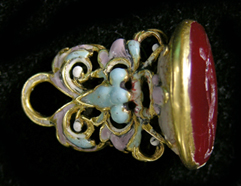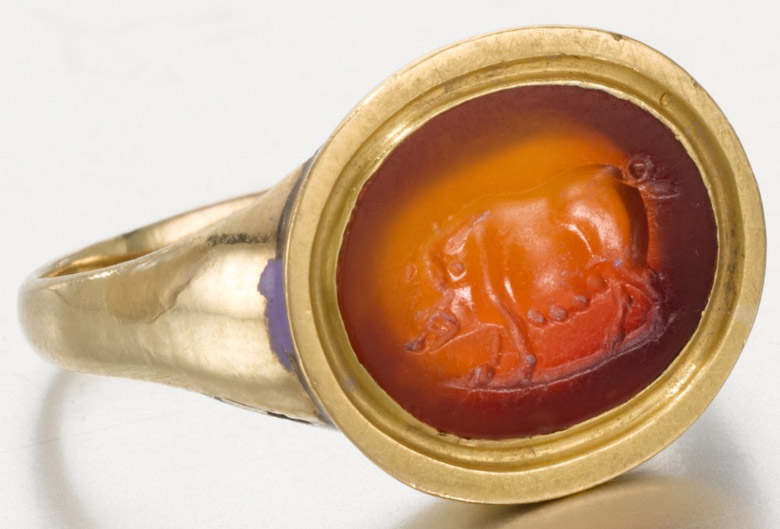Additions and corrections to the published catalogue
Theatrical masks on the Marlborough Gems
Professor J.R. Green (Sydney) kindly offers the following commentary on some pieces. References to masks (4XJ) are from his and A. Seeberg's revised third edition of T.B.L. Webster's, Monuments Illustrating New Comedy (1995)
291 = F. Ficoroni, Le maschere sceniche (1736) pl. 52. (4xJ 46)
327 Mask of a pornoboskos (brothel-keeper), perhaps copying a late 2nd-century original, with wavy rather than corkscrew beard.
342 Compare the mask 4XJ 10 and with it 4XJ 7. An old man, rather than pornoboskos (see in MNC i, 14-15). The whole series is a fine example of what happens when a picture gets adopted into the 'art' repertoire, removed from the actuality of the stage.
343 Probably echoes an early Hellenistic version, from the large eyes and shape of the beard.
365 Perhaps not ancient.
438 Both masks are comic, perhaps conceived as father and son.
439 Compare items listed under 4XJ 68 (pornoboskos).
440 Probably modern.
443 Certainly a cook, and the youth's mask is odd – mouth closed, and the head wreathed (?). Perhaps not ancient.
514 Almost certainly a cook.
515 This may echo an early Hellenistic prototype – the sleepy eyes (in MNC 'New Style'), but the form of the mouth with a hint of the actor's mouth within is rare so early – commoner from the 2nd century AD. It should be one of the wavy-haired (episeistos) masks and possibly the old man rather than the slave,
519 More likely a papposilenos than a pornoboskos. (4xJ 68,i)
623 The mask is of a youth, to whom Pan may be attracted,
711 Fairly certainly a cook.
We have identified that the following Marlborough gems were also published by F. Ficoroni, Le maschere sceniche (1736): possibly pl. 50, row 4.2 = 276, possibly pl. 68, 1 = 437, and pl.82, 2 = 520 (sold by Ficoroni to Medina).
British gem engravers
Julia Kagan, Gem engraving in Britain from antiquity to the present (Beazley Archive, 2010) includes full discussion also of British gem collectors, including the Duke of Marlborough and his sources.
The book also illustrates a number of the Marlborough gems:
Pls. 14.1 (165), 14.2 (108); p. 112, fig. 6.22a (429); pls. 20.2 (324), 21.1 (391); pp. 128, fig. 7.24 (753), 130, fig. 7.27 (373); pls. 25.1 (1), 25.2 (158), 35.2 (cf. 754 and p. 291), 42.4 (524).
Additions and corrections to the published catalogue by gem numbers
11
Sold at the auction at Christie's, New York on 29 April 2019, lot 27 (USD 118,750).
13
Sold at Sotheby’s: 5th December 2017, lot 71; (16,250 GBP).
46
This charming drawing, inspired by the seated grieving woman on the Marlborough gem, has recently been brought to our attention by James Baxendale. The drawing (circa 1770) is by Mary Hartley (1736-1803).The inscription (by Mary Hartley) to the drawing is ‘From a figure, (in a smaller size,) engraved by Bartolow’ after a broken gem in the Duke of Marlborough’s collection. The gem contains another female figure with a trumpet in her mouth, the rest broken off. This figure is supposed to be a conquered province’.
56
Belvoir Castle. Iron swivel ring with silver relief. Behind it is a cornelian intaglio.


[View larger image] [View larger image]
58
Sold by Fifth Avenue Art Galleries (New York) Jan. 16, 1909, lot 142
61
The Claudius Cameo appears in the Database of Art Objects at the Jeu de Paume, listed as one of the pieces of cultural plunder seized by the Einsatzstab Reichsleiter Rosenberg: (http://www.errproject.org/jeudepaume/card_view.php?CardId=8285).
It was taken from the Rothschild collection and has apparently been repatriated to France.

85
For a photo of the electrotype see 387.
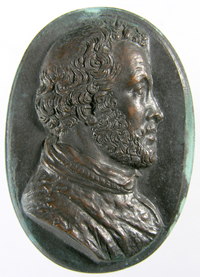
Acquired in 2014 from the antiquarian Rudigier in Munich by the Fritz Behrens Foundation (Hanover), now on permanent loan at the Herzog Anton Ulrich Museum in Brunswick (Inv. no. Gem L 953). We thank Dr Martina Minning for the information and the photo.
The following were in the Collection Fritz Gans (Friedrich L. von Gans, Frankfurt), published on plate 32 of his collection: 94, 114, 357, 362, 371, 510, 542 and an unidentified cameo (Oxford electrotype misnumbered 512).
The gems went to The Hague and were published in The Bachstitz Gallery collection: volume III: Objects of art and paintings, Berlin 1921.
101
101 is in the Fundación Lázaro Galdiano, Madrid, inventory number: 717 (CAMPS CAZORLA, Emilio en Inventario del Museo Lázaro 1948 – 1950).

114
Previous provenance: Friedrich Ludwig (Fritz) Gans (1833-1920), industrialist and collector, Frankfurt (according to a pencilled note in the 1875 album), Lucie Bigelow Rosen (1890-1968), New York: http://en.wikipedia.org/wiki/Lucie_Bigelow_Rosen; by descent; sold Thomaston Auction, Maine, USA, 6 November 2010, lot 271 ($70,000); private collection, London.
[View larger image] [View larger image]
Additional information: see entry 94
121

Sold at the auction at Christie's, New York on 29 April 2019, lot 26 (USD 52,500).
124

Sold at the auction at Christie's, New York on 29 April 2019, lot 31 (USD 212,500).
125
The following gems have been identified in a private collection in Texas:
125, 272, 418, 454, 469, 495, 631 and 684
195
Sold by Fifth Avenue Art Galleries (New York) Jan. 16, 1909, lot 149
208
Sold at Woolley & Wallis on 18 July 2019, lot 1279 (77,500 GBP).
220
The intaglio is described as a 17th Century chalcedony intaglio of a 'young Nero'.
The following attributes match records describing this item:
- Chalcedony with a whitish opaque layer atop a more translucent layer
- Ring has enameling as described in the Christies sales catalogue
- Intaglio is approximately 12 x 9mm which is within the margin of error for measurements contained in the Marlborough text (12 x 8mm)
- An impression of the gem matches the intaglio very well
221
This is the furthest from Blenheim a Marlborough gem has been traced so far. The current owner is Anne Schofield, in Sydney, Australia (http://www.anneschofieldantiques.com).
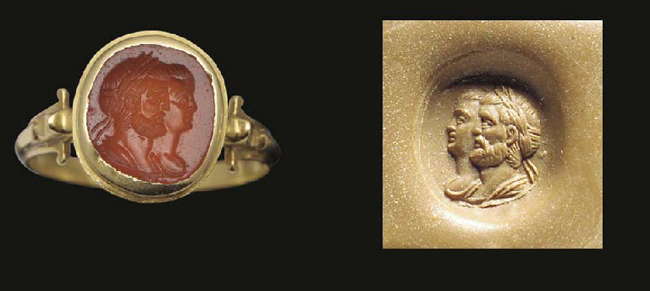
The gem was auctioned by Christie's 29th October 2003, lot 306 (£3,760)
227
For sale at Wartski for a reputed £500.000, the Arundel identification of Caesonia (instead of a Renaissance version of a portrait in the style of Faustina) is being revived by the dealers and Caligula himself suggested as former owner of the ring. We have dated it to the Renaissance, based on the style of the engraving (in particular the hair). The Daily Mail (29 September 2019) quotes Wartski director, Kieran McCarthy: 'We believe it belonged to the debauched Emperor Caligula and the engraving shows his final wife Caesonia.'
231
Sold by Fifth Avenue Art Galleries (New York) Jan. 16, 1909, lot 145
272
The following gems have been identified in a private collection in Texas:
125, 272, 418, 454, 469, 495, 631 and 684
326
Sold at the auction at Christie's, New York on 29 April 2019, lot 36 (USD 181,250).
328
Sold at the auction at Sotheby's on 2 July 2019, lot 81 (for 32,500GBP).
349
Additional photos.
[View larger image] [View larger image]
357
358
Now in the Getty. Sold at the auction at Christie's, New York on 29 April 2019, lot 35 (USD 435,000).
362
371
372
Now in the Getty. Sold at the auction at Christie's, New York on 29 April 2019, lot 33 (USD 350,000).
An Italian Renaissance bronze plaquette of the cameo was sold by Spink, London, 24 January 2008, lot 8 (£950). It is coming up for auction again: Morton & Eden, London, 9 December 2009, lot 2.

374
Now in the Getty. Sold at the auction at Christie's, New York on 29 April 2019, lot 34 (USD 237,500).
387
The photo of the electrotype is that of 85.
The cameo was possibly sold in the Rosenheim sale (Sotheby, 9th of May, 1923: lot 174). The cataloguer claims that the cameo is carved on crystal, with a portrait of Coligny, misidentified as Henry IV. The only Marlborough portrait of Hernry IV is this sapphire. The sale included another Marlborough cameo (573) with a less controversial attribution.
391
The former owner of the cameo, Tom Swope, has made us aware that it was indeed the original cameo (not a copy) mounted by Bulgari. He bought it at an antiques fair in Florida before arranging the BM purchase.
405
Sold at Sotheby’s: 10 December 2015, lot 430; (2,500 GBP)
This gem is now in a private collection in London
2.jpg)
.jpg)
414
Sold at Sotheby’s: May 2017, lot 72; (21,250 GBP).
.jpg)
418
The following gems have been identified in a private collection in Texas:
125, 272, 418, 454, 469, 495, 631 and 684
454
The following gems have been identified in a private collection in Texas:
125, 272, 418, 454, 469, 495, 631 and 684
461.34
The Natter intaglio was sold together with a modern 18 carat gold impression of the gem at Sotheby’s, London, 4 December 2013, lot 103. Other recent owners are Major Jones; Robertson Davies, Toronto, until 1995.
461.38
Current owner: Tom Swope, Hudson, New York. See Tom Swope's blog.
469
The following gems have been identified in a private collection in Texas:
125, 272, 418, 454, 469, 495, 631 and 684
474
Sotheby's, London, 4 July 1996 (European Sculpture and Works of Art from the collection formed by the British Rail Pension Fund) lot 63.
495
The following gems have been identified in a private collection in Texas:
125, 272, 418, 454, 469, 495, 631 and 684
498
Natter's design of the cameo appears on a small Wedgwood pot shown on the Antiques Roadshow (broadcast: BBC 1, 7.02.10, 19:00)

510
512
528
Bonhams, 28 Oct 2009, lot 323 (£31,200)
The oval stone is carved from layered agate, with two distinctive layers of cream above translucent brown, which Story-Maskelyne had wrongly thought to be 'glass imitating onyx'.
The brooch had belonged to the great-grandmother of the current owner. Jane Davies (1877-1972) lived in London from around 1900 until she was 91. She then came back to Pembrokeshire where she lived until her death in 1972 at the age of 95. The brooch was passed along the female line. Sara Crisp managed to identify the brooch as one of the missing Marlborough gems when she searched for 'cameo dog' on Google images and recognized the Beazley Archive picture of the electrotype.
The cameo is now for sale by the Gallery David Ghezelbash [12 rue Jacob
75006 Paris, France]; David Ghezelbash Archéologie (2010) no. 20
530
The Althorp leopard cameo, copied for the Duke of Marlborough, was sold by S.J. Phillips and illustrated on the cover of Further Wellington Gems and Historic Rings. Published on the Occasion of an Exhibition June 14-July 28 1978 (no.16).
531
Sold at the auction at EVE, Paris on 18th December 2019, lot 168.
536
This drawing of the gem in the British Museum was sold at Sotheby's NY, Wednesday 28 April 2010 (lot 41). It shows the cameo in its original frame (now lost), which reconstructed missing parts of the cameo and added drapery to the inner parts of the busts in gold.
542
573
Sold in the Rosenheim sale (Sotheby, 9th of May, 1923: lot 175), where it is identified as Empress Sabina. The sale included another Marlborough cameo (387)
574
Sold by Fifth Avenue Art Galleries (New York) Jan. 16, 1909, lot 143
576
Sold by Fifth Avenue Art Galleries (New York) Jan. 16, 1909, lot 144
605
The intaglio was sold by Sotheby’s, London, 6th Dec. 2016, lot 87 (sold for £25,000):
Flavio Sirletti (1683-1737); Italian, Rome, circa 1720
INTAGLIO WITH THE APOLLO BELVEDERE, MOUNTED AS A RING
608
Sold by Fifth Avenue Art Galleries (New York) Jan. 16, 1909, lot 147
631
The following gems have been identified in a private collection in Texas:
125, 272, 418, 454, 469, 495, 631 and 684
650
Has been bought by the Getty. Further provenance which was not known at the publication of the Marlborough volume has come to light:
Friedrich von Gans, Frankfurt am Main; Kurt Walter Bachstitz, The Hague, by 1920;
Dr. Hans Posse, Berlin (acquired from the above on behalf of Adolf Hitler for 6,000 NLG in the summer of 1941);
Adolf Hitler (transferred to the collection of the proposed Führermuseum in Linz, inv. no. 3877);
recovered in Altaussee, Austria by the so-called Monuments Men and transferred to the Central Collecting Point Munich on the 2nd July 1945 (inv. no. Mü 2255/12);
transferred to the Central Collecting Point Wiesbaden on the 29th July 1949;
transferred from the above to the Netherlands Art Property Collection, Holland (inv. no. NK 2904) on 2nd July 1951;
on loan from the above to the Geldmuseum, Utrecht and subsequently to the Dutch National Museum of Antiquities, Leiden;
Restituted to the heirs of Kurt Walter Bachstitz in 2016;
Sotheby’s, 6th Dec. 2016, lot 88 (sold for £ 398,750).
684
The following gems have been identified in a private collection in Texas:
125, 272, 418, 454, 469, 495, 631 and 684
708
Side view with mount
726Sold at the auction at Sotheby's on 2 July 2019, lot 73 (for 11,250 GBP).
727
Sold by Fifth Avenue Art Galleries (New York) Jan. 16, 1909, lot 146
741
Cheffins Auction, 12 December 2019, lot 120 (Sold for: £36000).
750
Previous collections: Seymour de Ricci, catalogue of a collection of ancient rings formed by the late E.Guilhou, Paris, 1912, no.410, plate VII; now private collection (London).
753
Now in the Getty. Sold at the auction at Christie's, New York on 29 April 2019, lot 37 (USD 2,115,000).
760
Has been found by Ittai Gradel, Copenhagen, who kindly provided the picture. It has been taken from the original mount described by Story-Maskelyn (‘prettily set’) by a previous owner and was probably broken in the process.
766
The original intaglio, now back in Blenheim Palace.
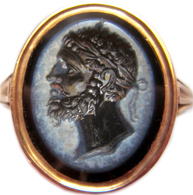
778
Sold by Fifth Avenue Art Galleries (New York) Jan. 16, 1909, lot 148
780
The intaglio was auctioned by Christie's, London, 20th May 2003, lot 32 together with a similar ring (£1,763)








.jpg)
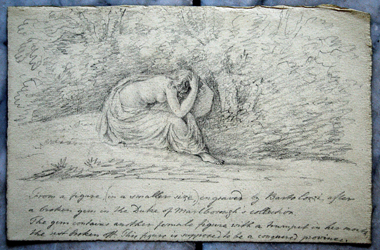




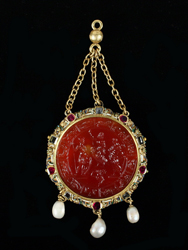


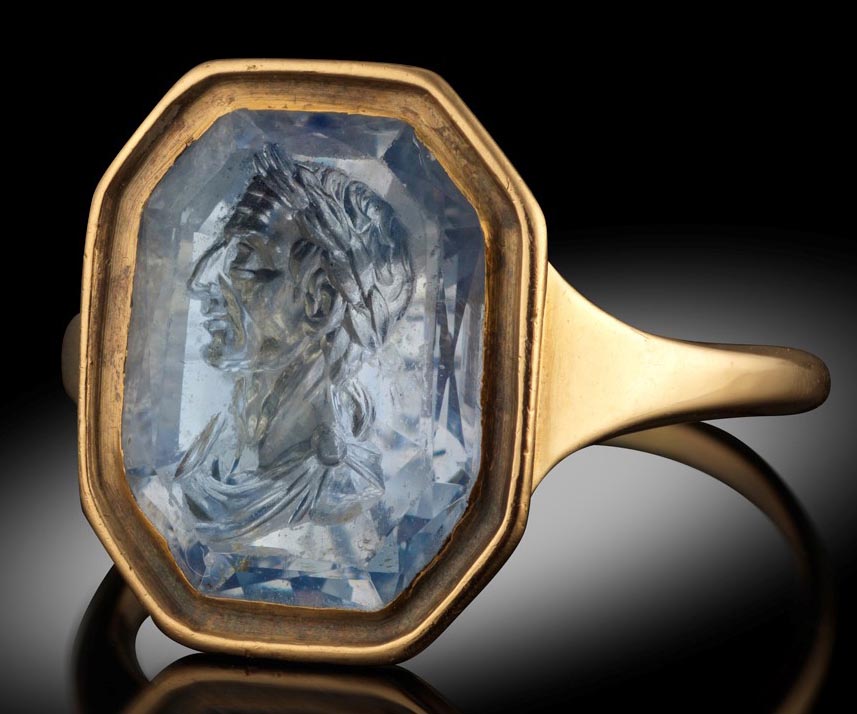
















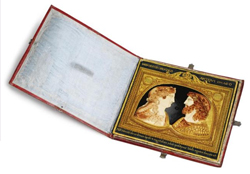
.jpg)
.jpg)
